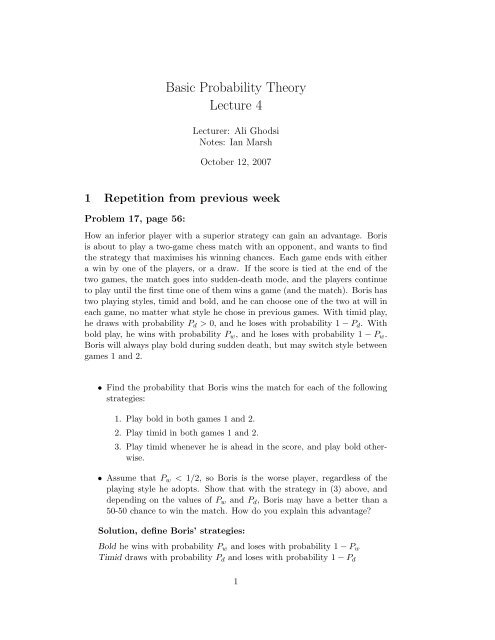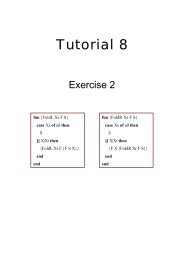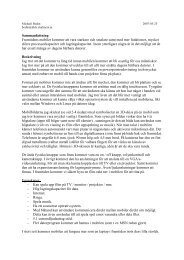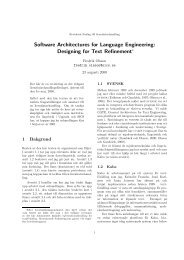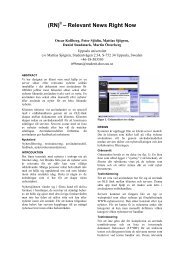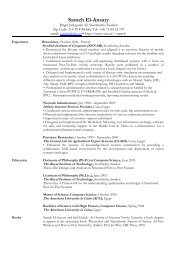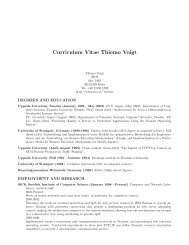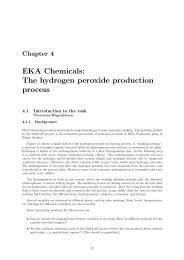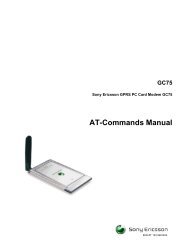Basic Probability Theory Lecture 4 - SICS
Basic Probability Theory Lecture 4 - SICS
Basic Probability Theory Lecture 4 - SICS
Create successful ePaper yourself
Turn your PDF publications into a flip-book with our unique Google optimized e-Paper software.
<strong>Basic</strong> <strong>Probability</strong> <strong>Theory</strong><br />
<strong>Lecture</strong> 4<br />
<strong>Lecture</strong>r: Ali Ghodsi<br />
Notes: Ian Marsh<br />
October 12, 2007<br />
1 Repetition from previous week<br />
Problem 17, page 56:<br />
How an inferior player with a superior strategy can gain an advantage. Boris<br />
is about to play a two-game chess match with an opponent, and wants to find<br />
the strategy that maximises his winning chances. Each game ends with either<br />
a win by one of the players, or a draw. If the score is tied at the end of the<br />
two games, the match goes into sudden-death mode, and the players continue<br />
to play until the first time one of them wins a game (and the match). Boris has<br />
two playing styles, timid and bold, and he can choose one of the two at will in<br />
each game, no matter what style he chose in previous games. With timid play,<br />
he draws with probability Pd > 0, and he loses with probability 1 − Pd. With<br />
bold play, he wins with probability Pw, and he loses with probability 1 − Pw.<br />
Boris will always play bold during sudden death, but may switch style between<br />
games 1 and 2.<br />
• Find the probability that Boris wins the match for each of the following<br />
strategies:<br />
1. Play bold in both games 1 and 2.<br />
2. Play timid in both games 1 and 2.<br />
3. Play timid whenever he is ahead in the score, and play bold otherwise.<br />
• Assume that Pw < 1/2, so Boris is the worse player, regardless of the<br />
playing style he adopts. Show that with the strategy in (3) above, and<br />
depending on the values of Pw and Pd, Boris may have a better than a<br />
50-50 chance to win the match. How do you explain this advantage?<br />
Solution, define Boris’ strategies:<br />
Bold he wins with probability Pw and loses with probability 1 − Pw<br />
Timid draws with probability Pd and loses with probability 1 − Pd<br />
1
Figure 1: Boris’s strategies<br />
P(Boris wins) = p 2 w + 2pw(1 − pw)pw<br />
The two separate terms correspond to the two outcomes we are interested<br />
in (win-win) and win-lose-win and lose-win-win (verify for yourselves which is<br />
which). With Pw = 7/16 and Pd = 7/8 the probability of P(Win) = 0.51. See also this weeks<br />
problems<br />
Problem 18, page 56<br />
Two players take turns removing a ball from a jar that initially contains m<br />
white and n black balls. The first player to remove a white ball wins. Develop<br />
a recursive formula that allows the convenient computation of the probability<br />
that the starting player wins.<br />
There are m = white balls and n = black balls, define the events:<br />
W = starting player wins<br />
I = starting player wins immediately<br />
We want, P(W) so using the total probability theorem:<br />
P(W) = P(I)P(W |I) + P(I c )P(W |I c )<br />
= m n<br />
· 1 +<br />
m + n m + n · P(W |Ic )<br />
2
W(m,n) is the probability that start wins given m white and n black balls.<br />
M(m,n) = m n<br />
+ W(m,n − 1)<br />
m + n m + n<br />
In recursive solutions we also need a stopping condition, W(m,0) = 1<br />
Problem 21, page 57<br />
The prisoner’s dilemma. Two out of three prisoners are to be released. One of<br />
the prisoners asks a guard to tell him the identity of a prisoner other than himself<br />
that will be released. The guard refuses with the following rationale: at your<br />
present state of knowledge, your probability of being released is 2/3, but after<br />
you know my answer, your probability of being released will become 1/2, since<br />
there will be two prisoners (including yourself) whose fate is unknown and exactly<br />
one of the two will be released. What is wrong with the guards reasoning?<br />
Ri = prisoner to be released<br />
3 prisoners of which you are one: 1 (you), 2, 3 An example of the wrong<br />
way to calculate the probability of release, i.e. not taking into account what<br />
the guard says.<br />
P(R1|R2) = P(R3|R2)P(R1|R2 ∩ R3) + P(R c 3 ∩ R2)P(R1|R2 ∩ R c 3)<br />
= 1/2(0) + 1/2(1) = 1/2<br />
The probability of saying that one is going to be released and actually being<br />
released is not the same. Using the table below helps solve the problem correctly.<br />
Alternatives <strong>Probability</strong><br />
1, 2 (guard says 2) 1/3<br />
1, 3 (guard says 3) 1/3<br />
2, 3 (guard says 2) 1/6<br />
2, 3 (guard says 3) 1/6<br />
P(1 is to be released | guard says 2) =<br />
1/3<br />
= 2/3<br />
1/3 + 1/6<br />
3<br />
P(1 is to be released and guard says 2)<br />
P(guard says 2)
So, the probability of 1 being released is 2/3 despite what the guard says.<br />
2 Independence<br />
Events A and B are independent, iff (if and only if )<br />
P(A|B) = P(A)<br />
One other way to see it is that the event B does not bring any extra information.<br />
This is equivalent to:<br />
iff A is independent of B then:<br />
P(A|B) =<br />
P(A ∩ B)<br />
P(B)<br />
P(A)P(B) = P(A ∩ B)<br />
which works even when P(B) = 0. Also it shows that the order is not important.<br />
Ali’s quote “the point is that is is distinct and non-interacting physical<br />
process.”<br />
Note: independence does not mean disjunctivity. The reverse is true, disjoint<br />
implies dependence.<br />
One other quote “Proportion of A to Ω is equal to the proportion of (A ∩ B)<br />
to B”.<br />
Example: P(A) > 0,P(B) > 0 P(A ∩ B) = 0 i.e. disjoint<br />
Example 1.19, page 34<br />
a) Are the events, Ai and Bj independent?<br />
Ai = {first roll is i}<br />
Bj = {second roll is j}<br />
P(Ai) = 1/4,P(Bi) = 1/4<br />
P(Ai ∩ Bj) = 1/16<br />
which is equal to P(Ai)P(Bj)<br />
So, the events are independent.<br />
b) 2 rolls of a 4 sided die, are the following events independent?<br />
4
(add epsfig)<br />
Ai = {first roll is a 1}<br />
Bi = {sum of the two rolls is 5}<br />
P(Ai) = 4/16<br />
P(Bi) = 4/16<br />
P(Ai ∩ Bi) = 1/16<br />
P(Ai)P(Bi) = 4/16 · 4/16 = 1/16<br />
P(A ∩ B) = P(A)P(B), therefore events A and B are independent.<br />
c) Are these independent?<br />
A = {maximum of the two rolls is 2}<br />
B = {minimum of the two rolls is 2}<br />
P(A ∩ B) = P(< 2,2 > −roll) = 1/16<br />
P(A) = 3/16 (1,1),(1,2)(2,1)<br />
P(B) = 5/16<br />
P(A)P(B) = 3 · 5/2 8 = 1/16<br />
Problem 28. The king’s sibling. The king has only one sibling. What is<br />
the probability that the sibling is male? Assume that every birth results in a<br />
boy with probability 1/2, independent of other births. Be careful to state any<br />
additional assumptions you have to make in order to arrive at an answer.<br />
<strong>Probability</strong> A king who has one sibling, parents getting a boy was/is 0.5 and<br />
independent.<br />
Prob({king having brotherhood} = 1/2 — king is a boy) = 1/2<br />
BB = parents had a boy, then another boy (BB, BG, GB, BB)<br />
OB = parents had at least one boy<br />
P(BB|OB) = (BB∩OB)<br />
P(OB)<br />
1/4<br />
= 3/4 = 1/3<br />
2.1 Conditional independence<br />
Commonly used in statistics.<br />
A and B are conditionally independent given C<br />
P(A|B ∩ C) = P(A|C)<br />
5
P(A|B ∩ C) = P(A∩B∩C)<br />
= P(C)P(B|C)P(A)<br />
P(B∩C)<br />
P(A ∩ B|C) = P(A∩B∩C)<br />
P(C)<br />
P(B|C)P(A|B ∩ C)<br />
using P(A|B ∩ C) = P(A|C)<br />
= P(C)P(B|C)P(A|B∩C)<br />
P(C)<br />
P(B|C)P(A|C) no divide by zero problems.<br />
Now, compare conditional independent with independence<br />
Example 1.20, page 36<br />
Example 1.20. Consider two independent fair coin tosses, in which all four possible<br />
outcomes are equally likely. Two coin tosses, H1 = 1st head, H2 = 2nd<br />
head, D = tosses have different values P(H1 ∩ H2) are they independent?<br />
= 1/4 (H, H)<br />
P(H1) = 1/2 and P(H2) = 1/2<br />
P(H1|D) = 1/2<br />
P(H2|D) = 1/2<br />
P(H1 ∩ H2|D) = 0 = P(H1|D)P(H2|D)<br />
H1 and H2 conditionally independent<br />
A and B are not conditionally independent given D.<br />
Example 1.21, page 37<br />
Example 1.21. There are two coins, a blue and a red one. We choose one of the<br />
two at random, each being chosen with probability 1/2, and proceed with two<br />
independent tosses. The coins are biased: with the blue coin, the probability<br />
of heads in any given toss is 0.99, whereas for the red coin it is 0.01.<br />
Red coin, blue coin. Pick one coin randomly<br />
P(R) = 1/2<br />
P(B) = 1/2<br />
Toss that coin twice<br />
H1 = first toss head H2 = second toss head<br />
P(Hi|B) = 0.99 P(Hi|R) = 0.01<br />
Find the independence and conditional independence of H1 and H2.<br />
6
P(H1 ∩ H2|R) = P(H1|R)P(H2|R)<br />
Lhs = (0.01) 2<br />
H1 and H2 are conditional independent given R and B.<br />
P(H1) = P(R)P(H1|R) + P(R c )P(H1|R c )<br />
using the total probability theorem, divide the state space into red and blue<br />
1/2 · 0.01 + 0.99 ∗ 1/2 = 1/2<br />
H(H2) = 1/2<br />
P(H1) · P(H2) = 1/4<br />
P(H1 ∩ H2) = P(R)(P(H1 ∩ H2|R) + P(R c )P(H1 ∩ H2|R c )<br />
= 1/2 · 0.01 2 + 1/2 · 0.99 2<br />
≈ 1/2<br />
conditional independence and independence do not imply each other.<br />
3 Homework problems<br />
In problem 17 we looked at different strategies for winning a chess game. The<br />
question is, how bad can a player be and yet still win the game. Motivate your<br />
choice of values and explain your answer in simple terms to a non-technical<br />
person (i.e. probability student). In other words reason your answer.<br />
Do 23, 24, 25, 26 from the problem section (pages 57-58)<br />
7


